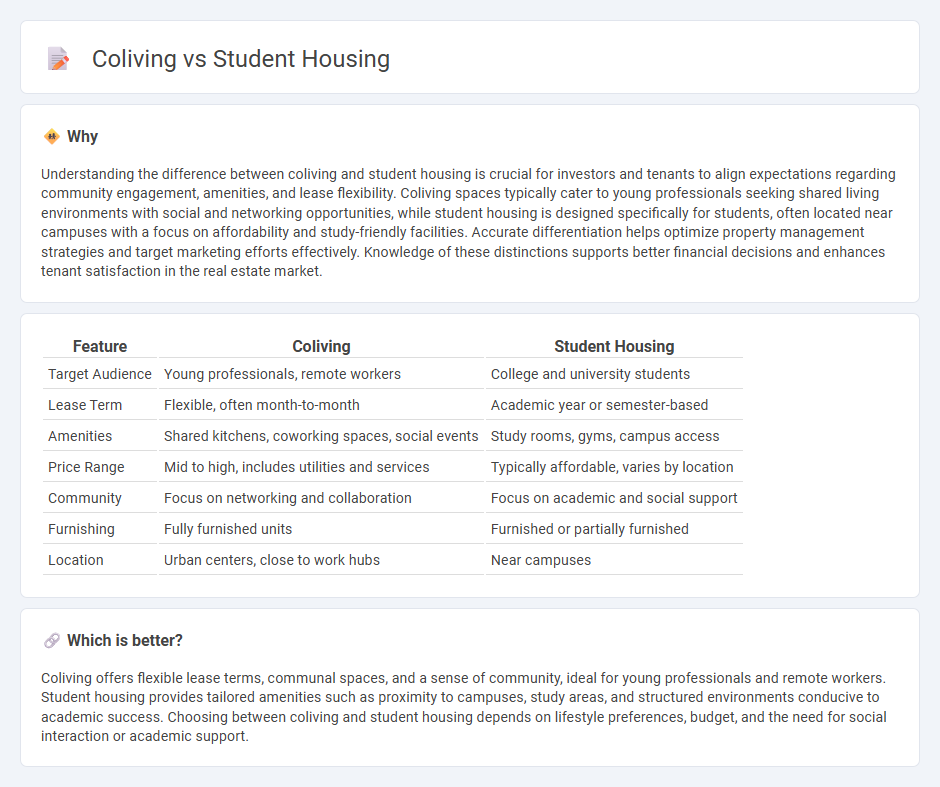
Coliving spaces offer flexible leases and community-oriented living with shared amenities designed for young professionals and remote workers, emphasizing affordability and social interaction. Student housing typically provides dormitory-style or apartment accommodations focused on proximity to campus, academic support, and student lifestyle needs. Explore the nuances of coliving versus student housing to determine the best fit for your living preferences.
Why it is important
Understanding the difference between coliving and student housing is crucial for investors and tenants to align expectations regarding community engagement, amenities, and lease flexibility. Coliving spaces typically cater to young professionals seeking shared living environments with social and networking opportunities, while student housing is designed specifically for students, often located near campuses with a focus on affordability and study-friendly facilities. Accurate differentiation helps optimize property management strategies and target marketing efforts effectively. Knowledge of these distinctions supports better financial decisions and enhances tenant satisfaction in the real estate market.
Comparison Table
| Feature | Coliving | Student Housing |
|---|---|---|
| Target Audience | Young professionals, remote workers | College and university students |
| Lease Term | Flexible, often month-to-month | Academic year or semester-based |
| Amenities | Shared kitchens, coworking spaces, social events | Study rooms, gyms, campus access |
| Price Range | Mid to high, includes utilities and services | Typically affordable, varies by location |
| Community | Focus on networking and collaboration | Focus on academic and social support |
| Furnishing | Fully furnished units | Furnished or partially furnished |
| Location | Urban centers, close to work hubs | Near campuses |
Which is better?
Coliving offers flexible lease terms, communal spaces, and a sense of community, ideal for young professionals and remote workers. Student housing provides tailored amenities such as proximity to campuses, study areas, and structured environments conducive to academic success. Choosing between coliving and student housing depends on lifestyle preferences, budget, and the need for social interaction or academic support.
Connection
Coliving and student housing both emphasize affordable, community-focused living spaces that cater to young professionals and students seeking convenience and social interaction. Shared amenities, flexible lease terms, and proximity to educational institutions make coliving an appealing model within student housing markets. Growing urbanization and rising housing costs drive demand for these integrated residential concepts that blend affordability with a strong sense of community.
Key Terms
Lease Structure
Student housing leases typically offer fixed-term agreements aligned with academic calendars, often spanning 9 to 12 months, providing stability for the academic year. Coliving arrangements feature more flexible lease structures, including month-to-month or shorter-term contracts, catering to transient lifestyles and diverse tenant needs. Explore the nuances in lease terms to determine which housing option best suits your living preferences and commitments.
Amenities
Student housing often includes essential amenities such as study rooms, laundry facilities, and high-speed internet tailored to academic needs. Coliving spaces enhance community living by offering shared kitchens, coworking areas, and social events designed to foster networking and collaboration. Explore further to understand which living arrangement best suits your lifestyle preferences and academic goals.
Occupant Demographics
Student housing primarily serves college and university students aged 18-24, offering affordable, conveniently located accommodations that support academic lifestyles and social engagement. Coliving spaces attract a broader demographic, including young professionals, digital nomads, and creatives typically aged 20-35, emphasizing community, shared amenities, and flexible leases. Explore detailed comparisons of occupant demographics to understand which living arrangement best suits your lifestyle needs.
Source and External Links
University Park Housing - Offers a variety of housing options for students including traditional residence halls, suites, single-occupancy rooms, and apartments.
UC Davis Student Housing and Dining Services - Provides on-campus residence halls for freshmen with guaranteed housing, near classes and campus recreation.
BYU Housing - Requires single undergraduate students to live in BYU On-Campus Housing, Off-Campus Contracted Housing, or with family members.
 dowidth.com
dowidth.com